In October/November 2022, we went on two back-to-back cruises around the Mediterranean, spending a total of 24 nights on the two ships. These are the Italian ports, of which there were many!
Click here to read our review of the two ships, and click here to read about the non-Italian ports.
Naples, Italy
When we were previously in Naples, we went straight from the cruise port to Pompeii. Our impression from the walk from the port to the train station was that the city seemed dirty and depressing, with abundant trash and grime and frighteningly aggressive drivers. Also, great pizza!
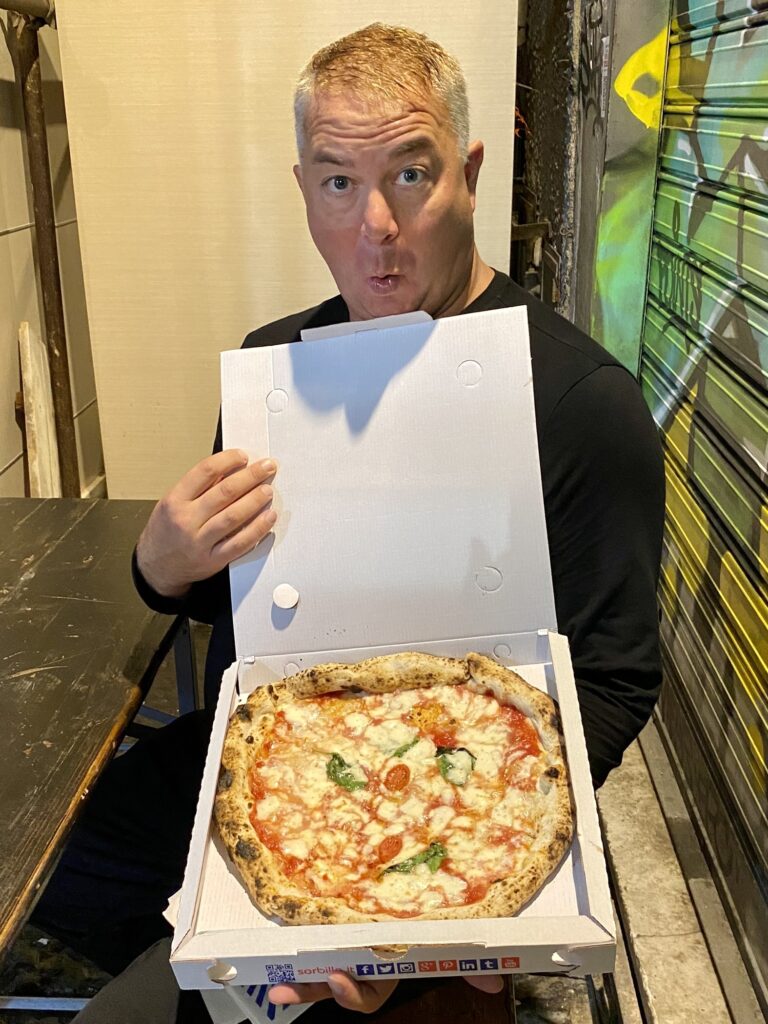
For these two port visits, we decided to explore the gritty markets in the eastern portion of the city, and also walk around the historic core.
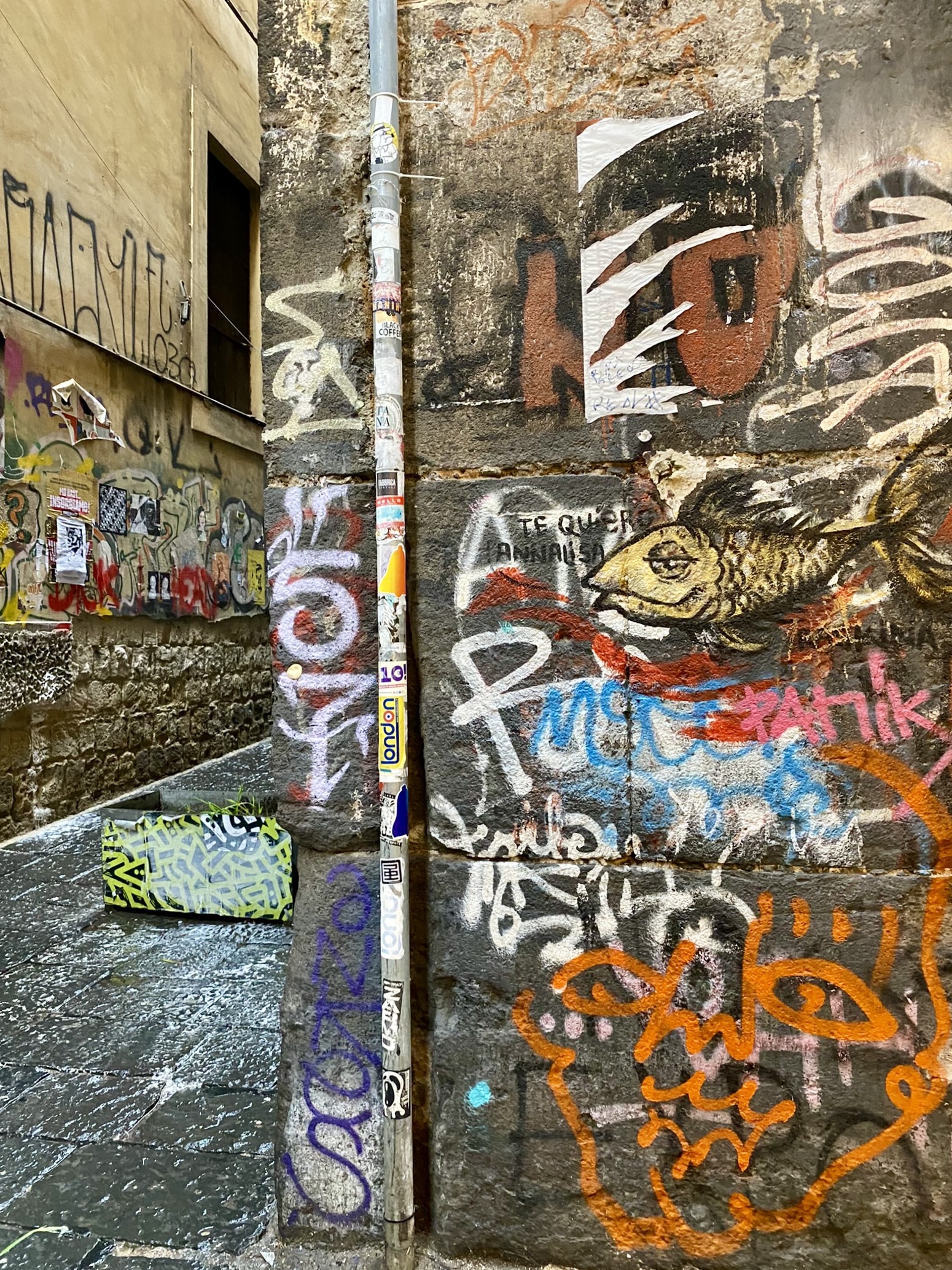
Typically when we see a market on the map in Italy (or Europe in general), we head there to enjoy the selections of meat and seafood, and typically nosh on whatever is available: bread, oysters, charcuterie, and so many cheeses.
The Mercato di Porta Nolana has some of this. But mostly it had shoes. So many shoes, and used clothes, and possibly-stolen goods. Blocks and blocks of this, in alleys and parking lots and at tables on the outskirts of parks.
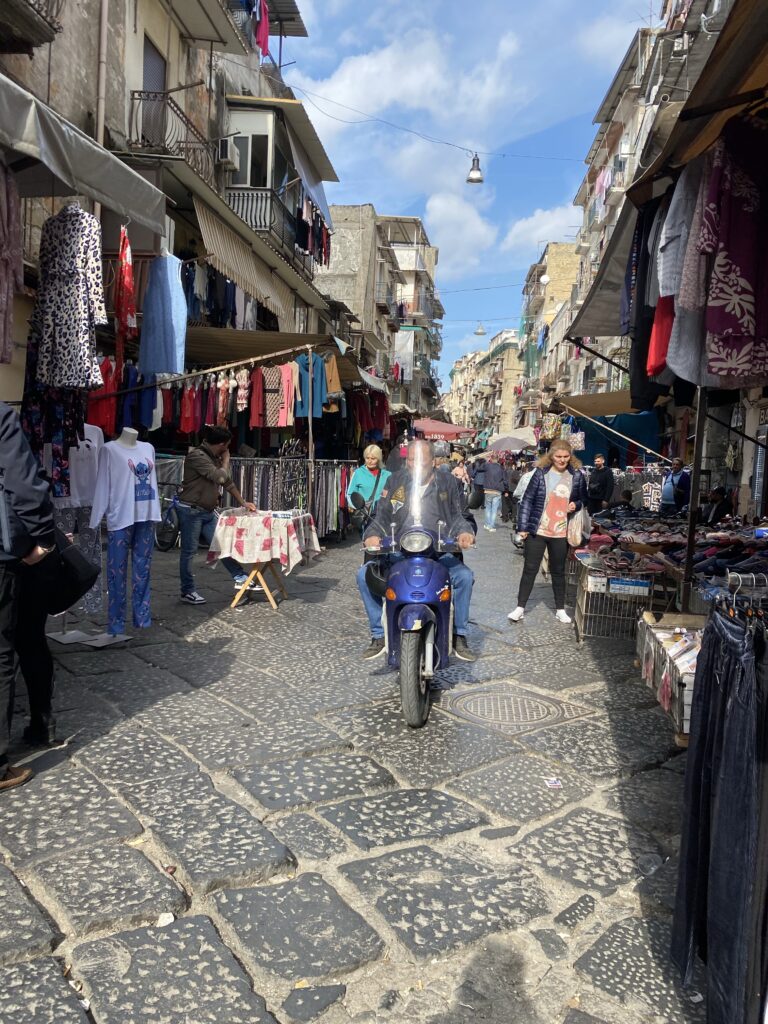
It was more like a wide-ranging swap meet, and not a pleasant experience for us. Some points were quite crowded and often a scooter would squeal by honking to clear the way. Even the storefronts seemed to be somewhat transitory: lacking signage, many seem to sell whatever goods they got off a recent boat from China, sometimes still on the pallet. One store we did frequent was a cheap sunglass wholesaler, who offered the same goods that the street vendors were selling, but without the haggling. I suspect this store may be the source for many of the street vendors, so we skipped the middleman and stocked up on sunglasses that we had no problem losing or breaking.
The town core is somewhat hilly, and we spent a day walking around, including the famous Via dei Tribunali. Given the season, we especially enjoyed the area around Via San Gregorio Armeno, the “Naples Nativity Street,” where different workshops had all types of Christmas crafts, from small trinkets to artisan carvings.
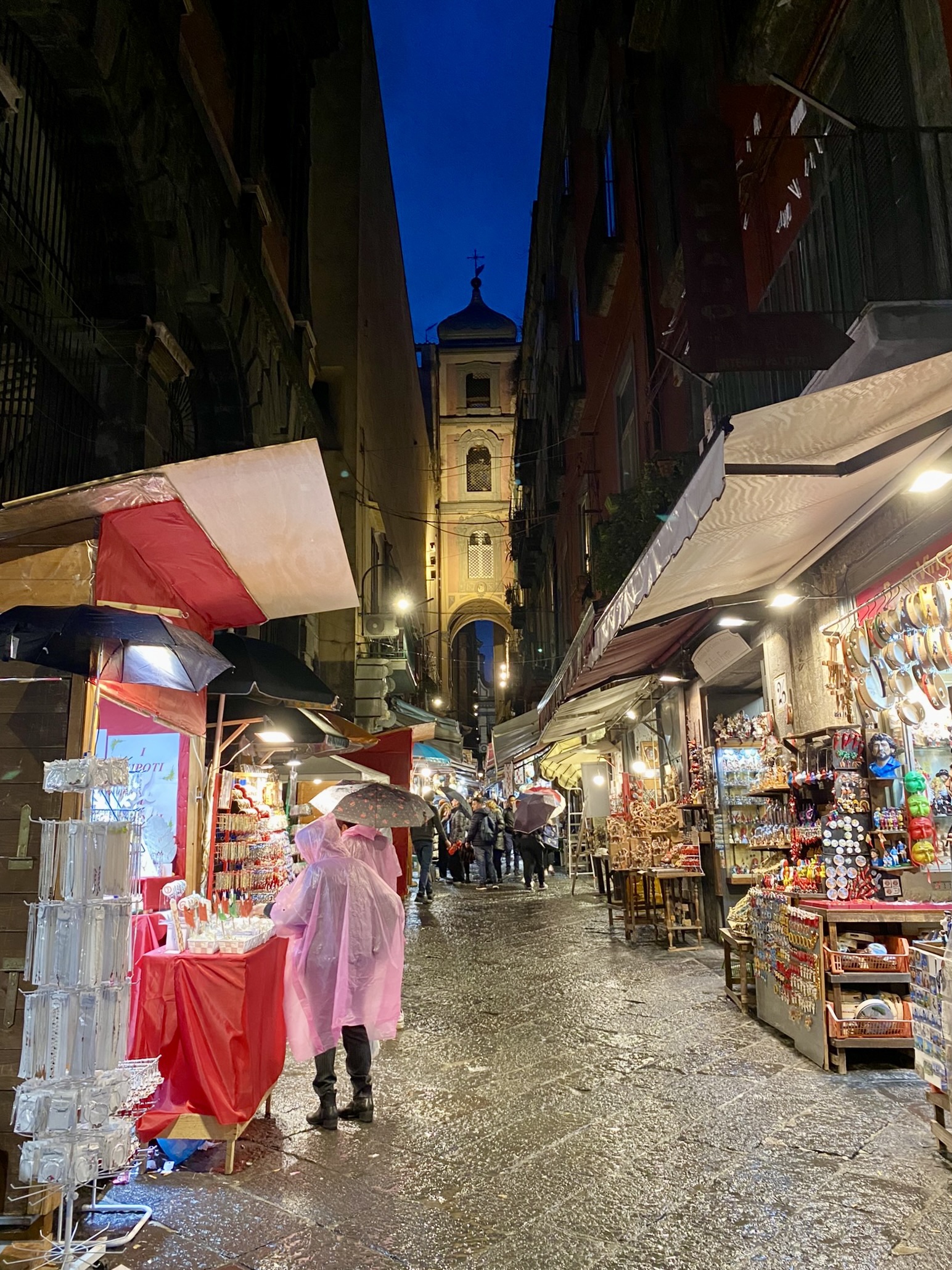
Between meals, we walked through the botanical garden (Orto Botanico). Completely fenced in, and free to enter, it is a lovely respite from the grit of the rest of Naples. Honestly, we forgot we were even in a big city!
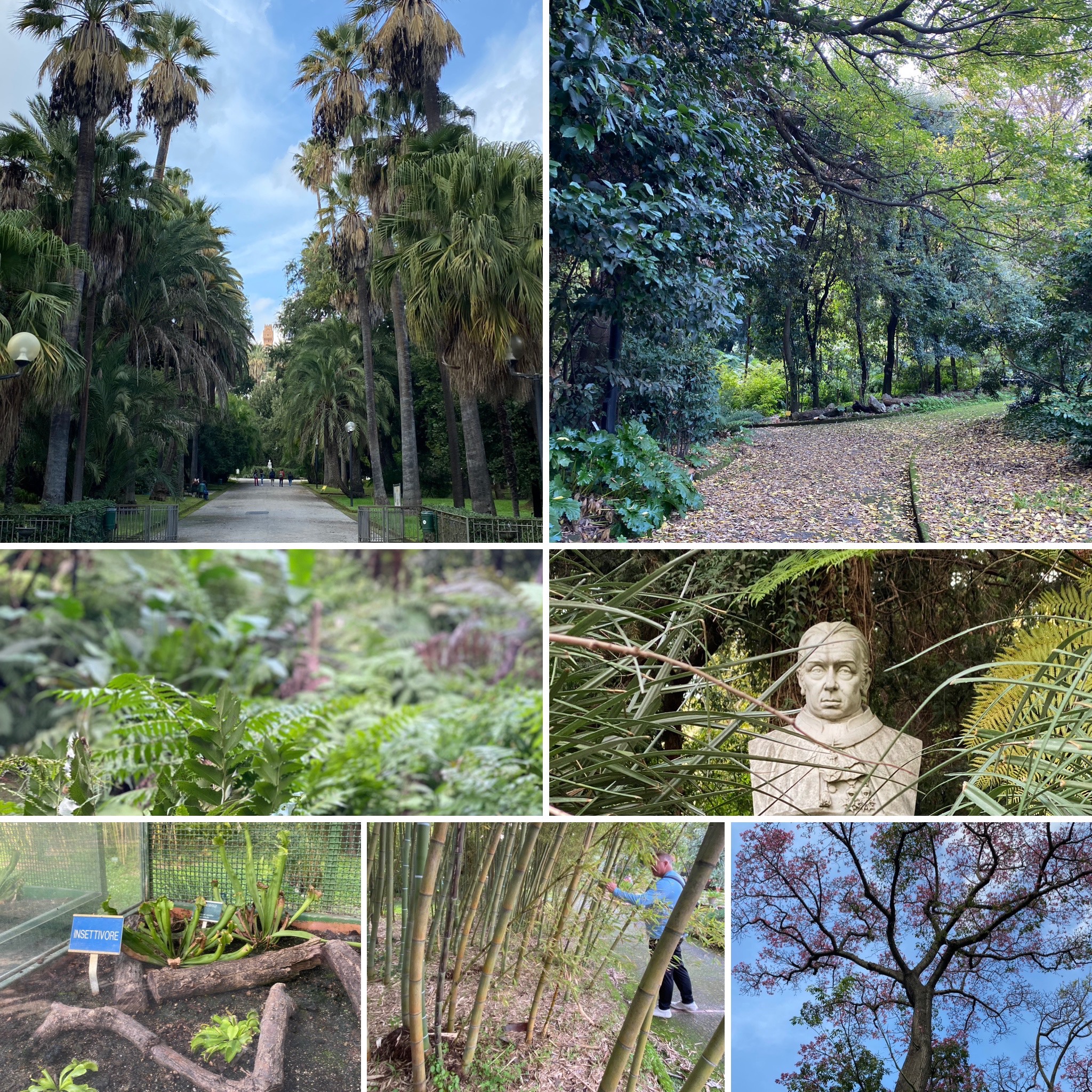
We had pizzas at multiple spots, and they are remarkably inexpensive for the quality (under $10 USD for a whole pie).
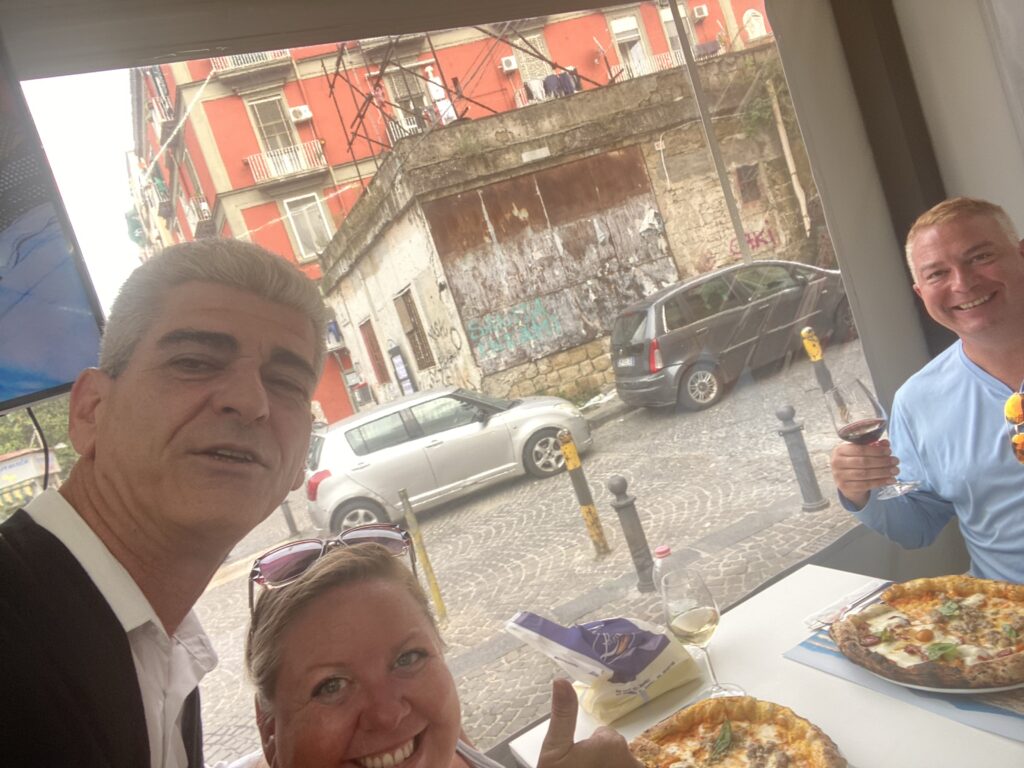
As the afternoon was getting started, we approached a street vendor that, from afar, appeared to be selling mulled wine. We thought ooh, that sounds nice on this briskish day. It turned out to be octopus, simmering away in an inky, flavorful broth.
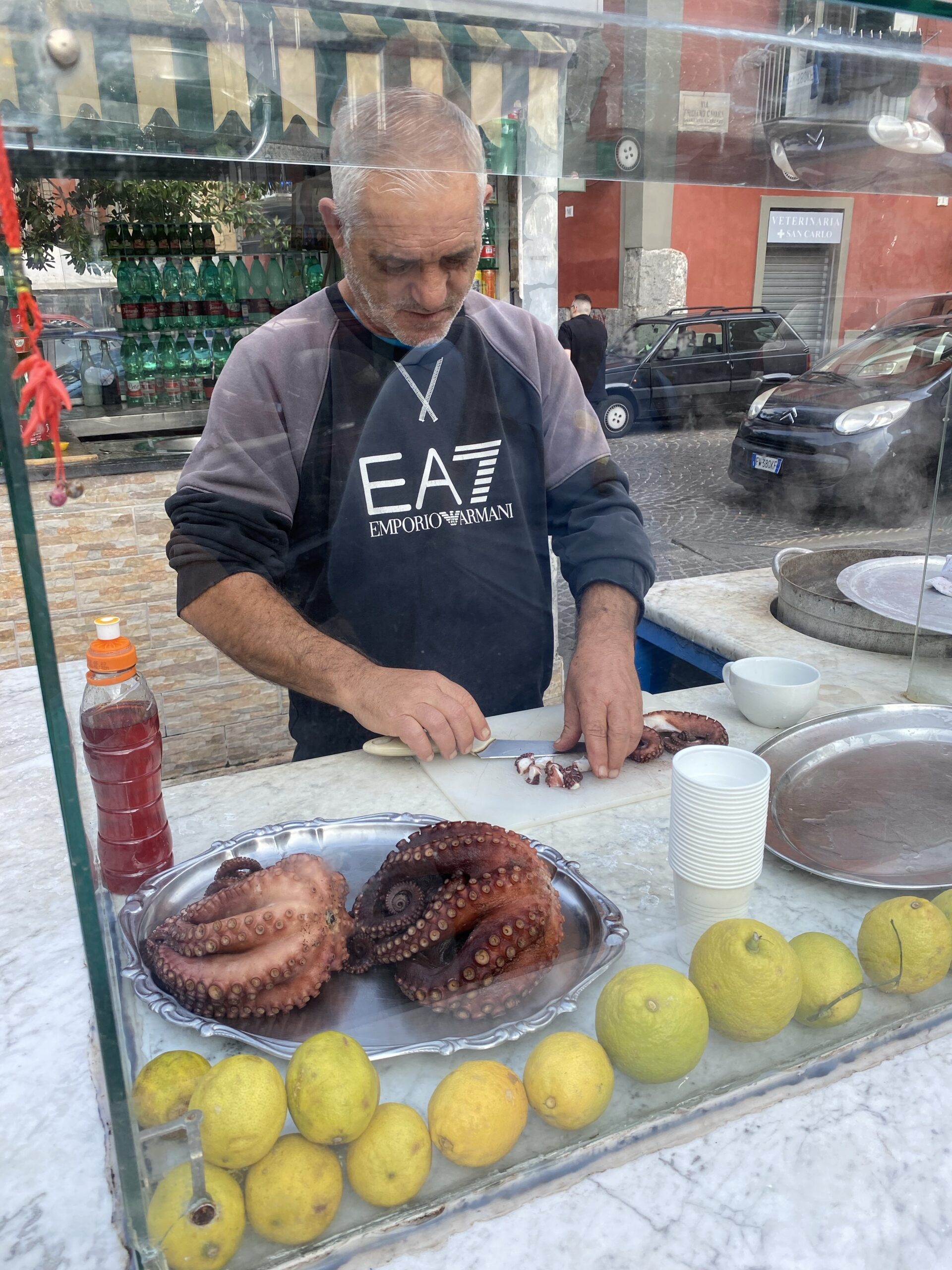
It is served in a cup to drink, with some octopus pieces in the broth that are retrieved with toothpicks. Very economical and flavorful! We both loved this traditional Neapolitan snack and if you’d like to read more about this, check out this short article.
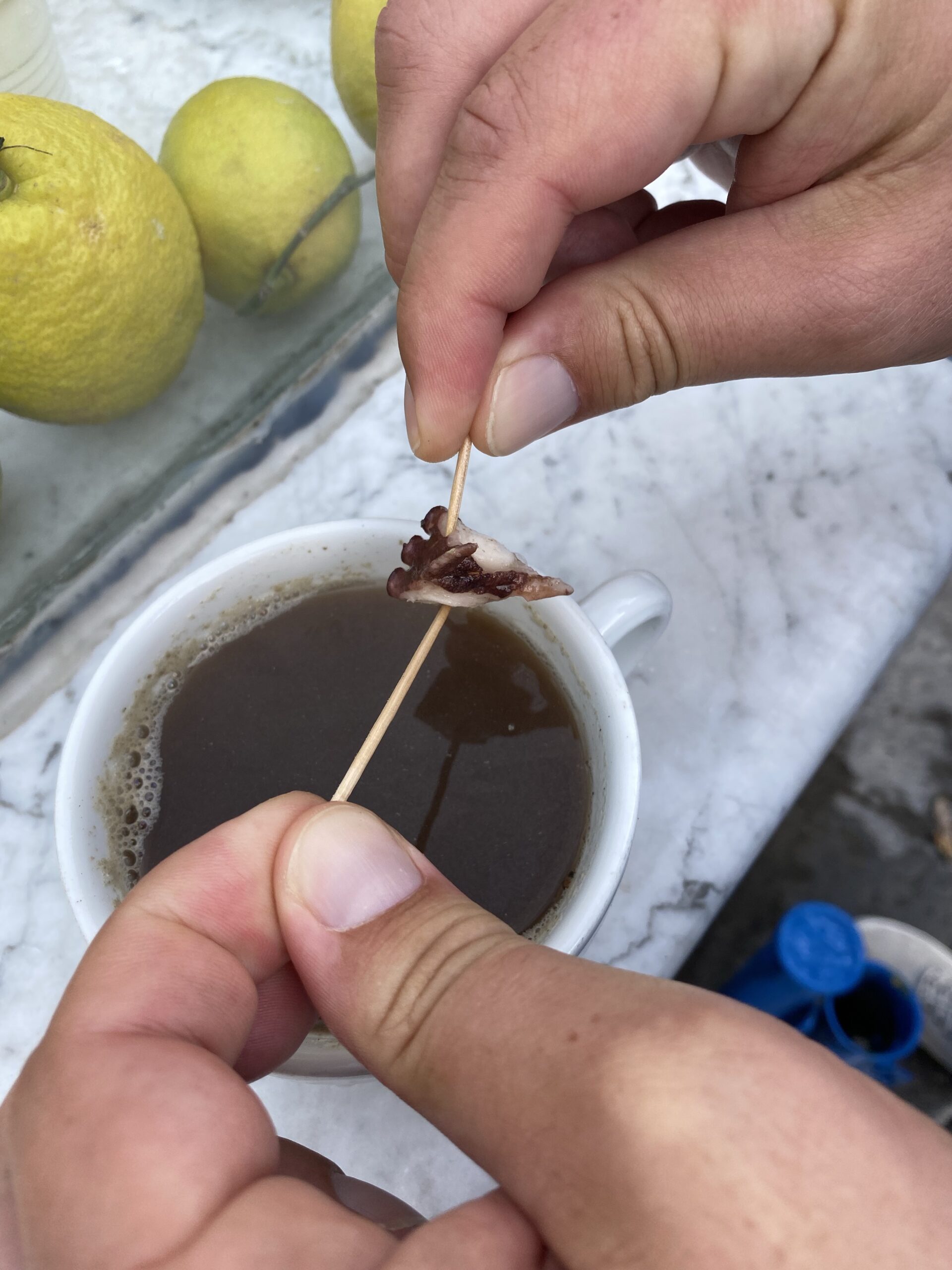
Naples is quite the foodie area and has unique food options. For example, I saw a tripe stand and decided to partake. When in Rome, uh, Naples! While the sign showed a half-dozen methods of preparation, there was actually only one way offered: lemon-and-salt.
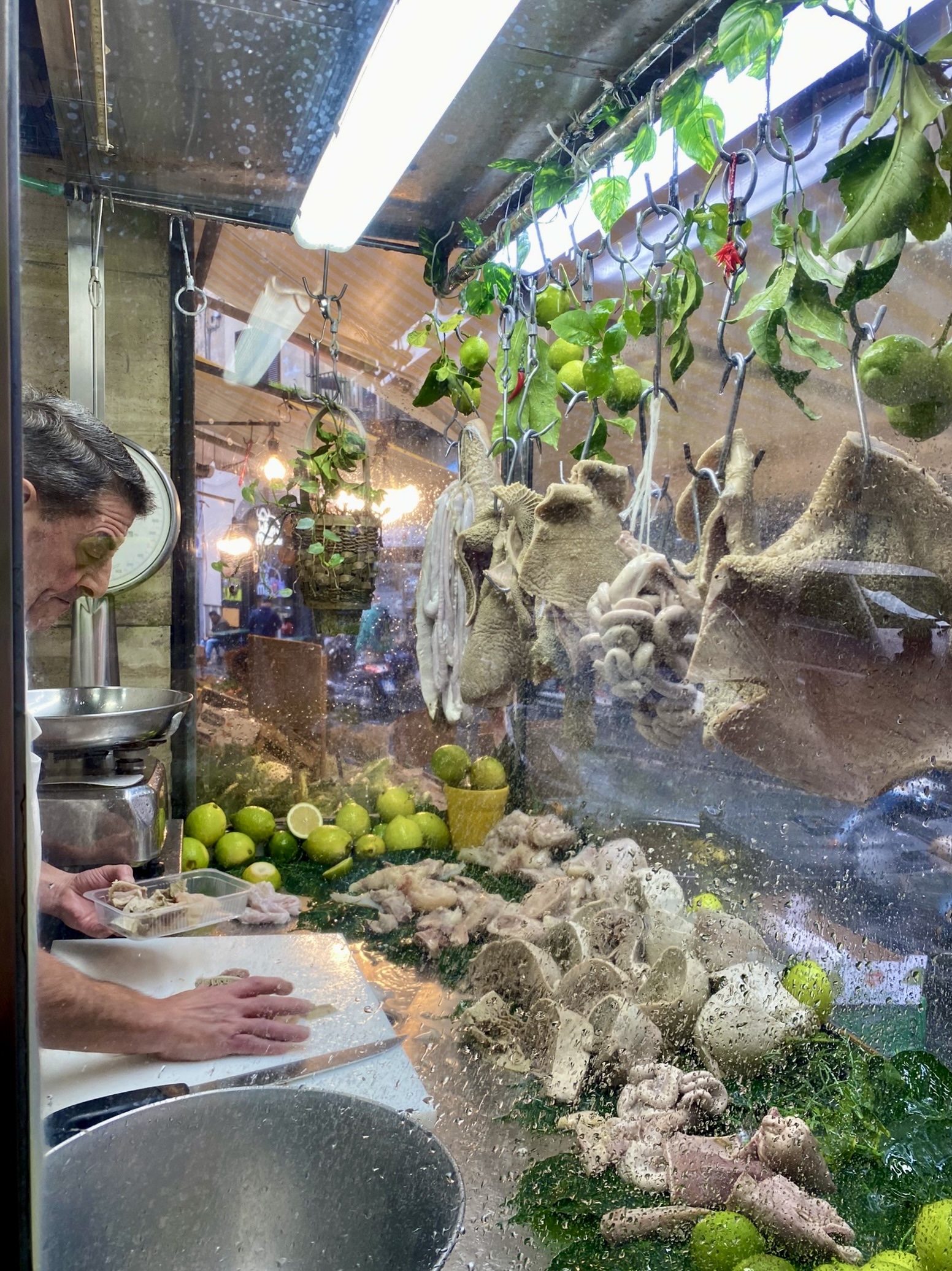
The proprietor took his time to pull down various hunks of offal, chopping them into bite-sized pieces. This was all finished with the squeezing of an entire large lemon, which he deftly juiced by hand, and a generous sprinkling of sea-salt. Like the squid, this was a dish to be consumed with toothpicks, and over the next hour of walking, I slowly enjoyed an authentic trippa experience. Tammy took photos and declined to try any.
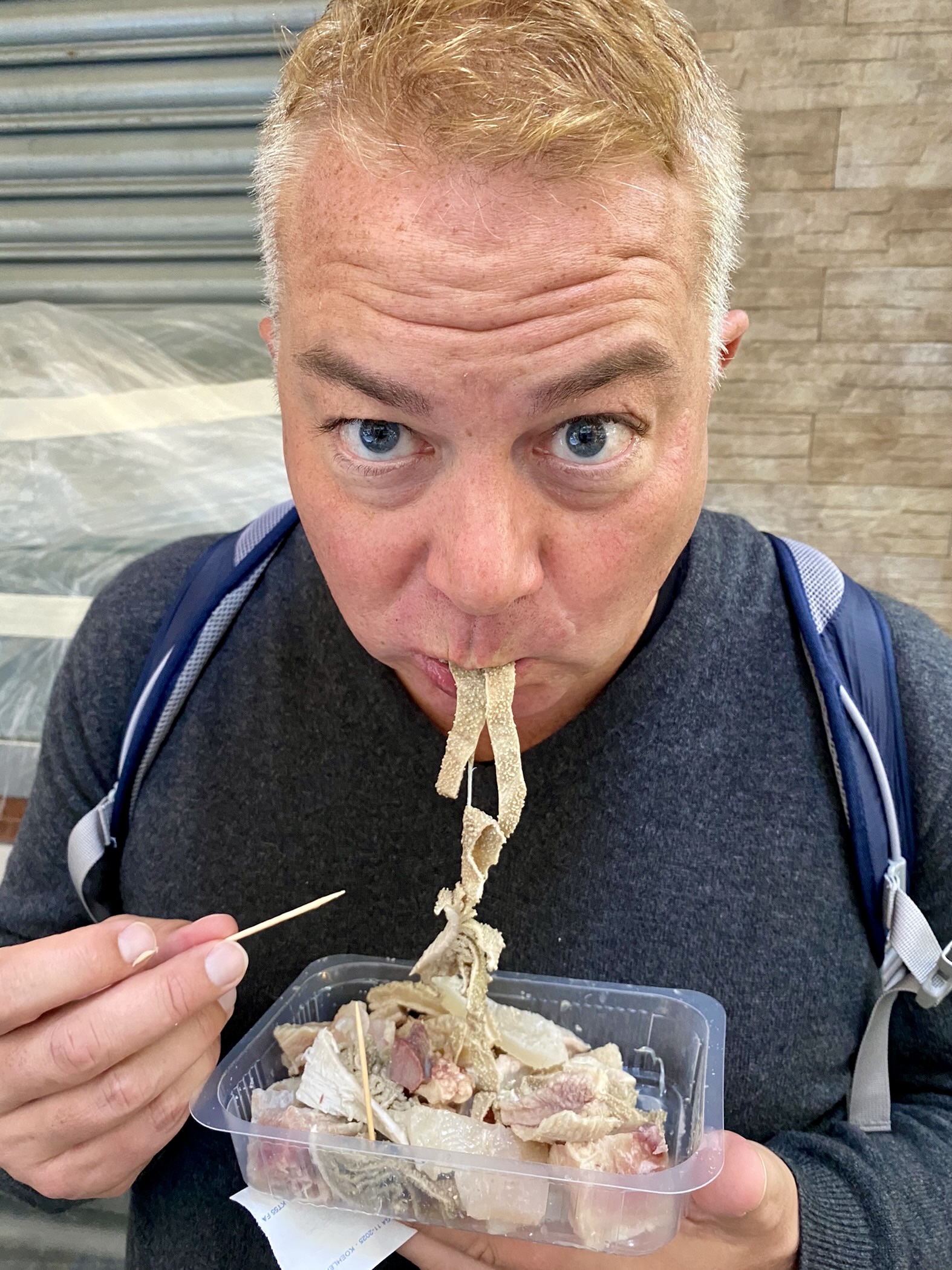
Near the markets, there is a statue very popular with tourists….
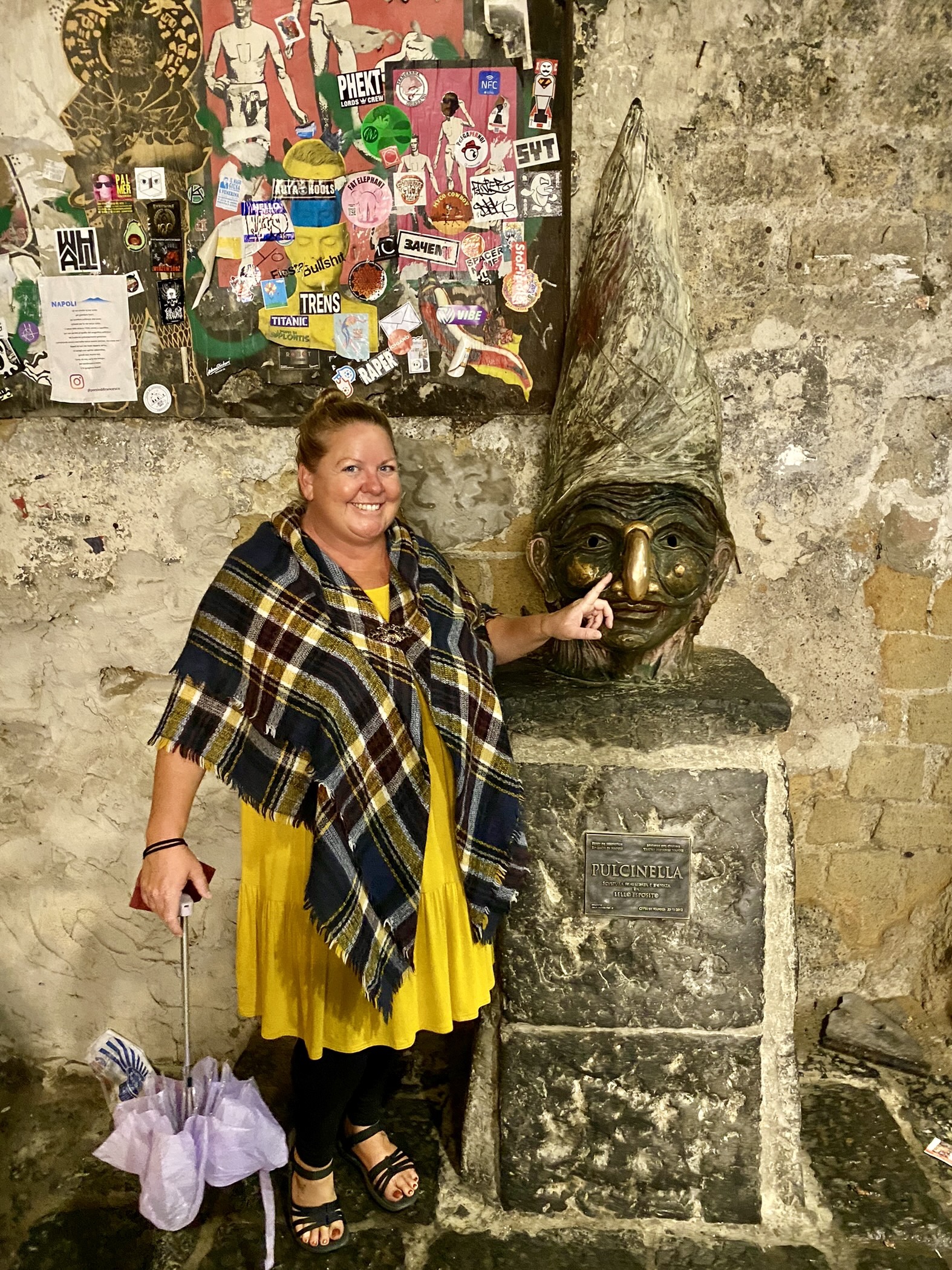
Other than the glorious culinary delights, we did not find a lot to offer in Naples. If we come back, we will likely head straight out of town (although the train station is not especially close to the port), but try to leave enough time to come back in for at least one meal.
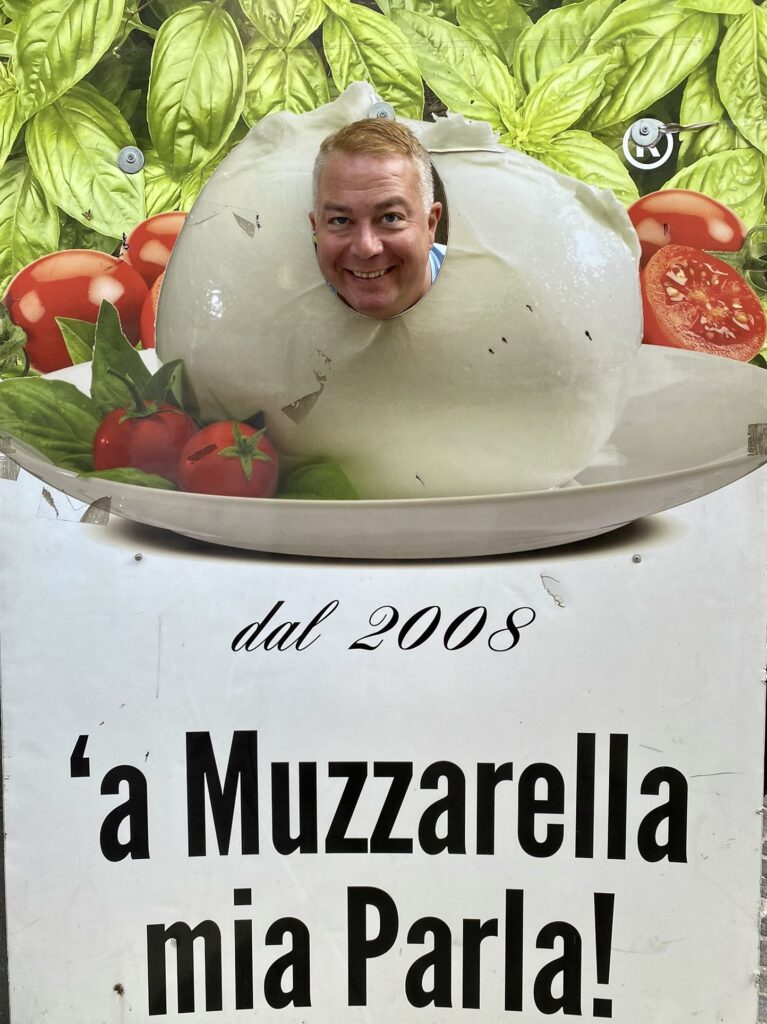
Genoa (aka Genova), Italy
It’s funny to me how certain people get huffy about the “correct” pronunciation of some European towns. Typically this is just the pronunciation in the local language, like the lispy exaggerated pronunciation of Barthelona. Yet I went my entire life without hearing any American use the name Genova, as the Italians call this city. The American sausage is “Genoa salami,” and I had no idea the Italians said it differently until I saw a large sign as the ship was sailing into port.
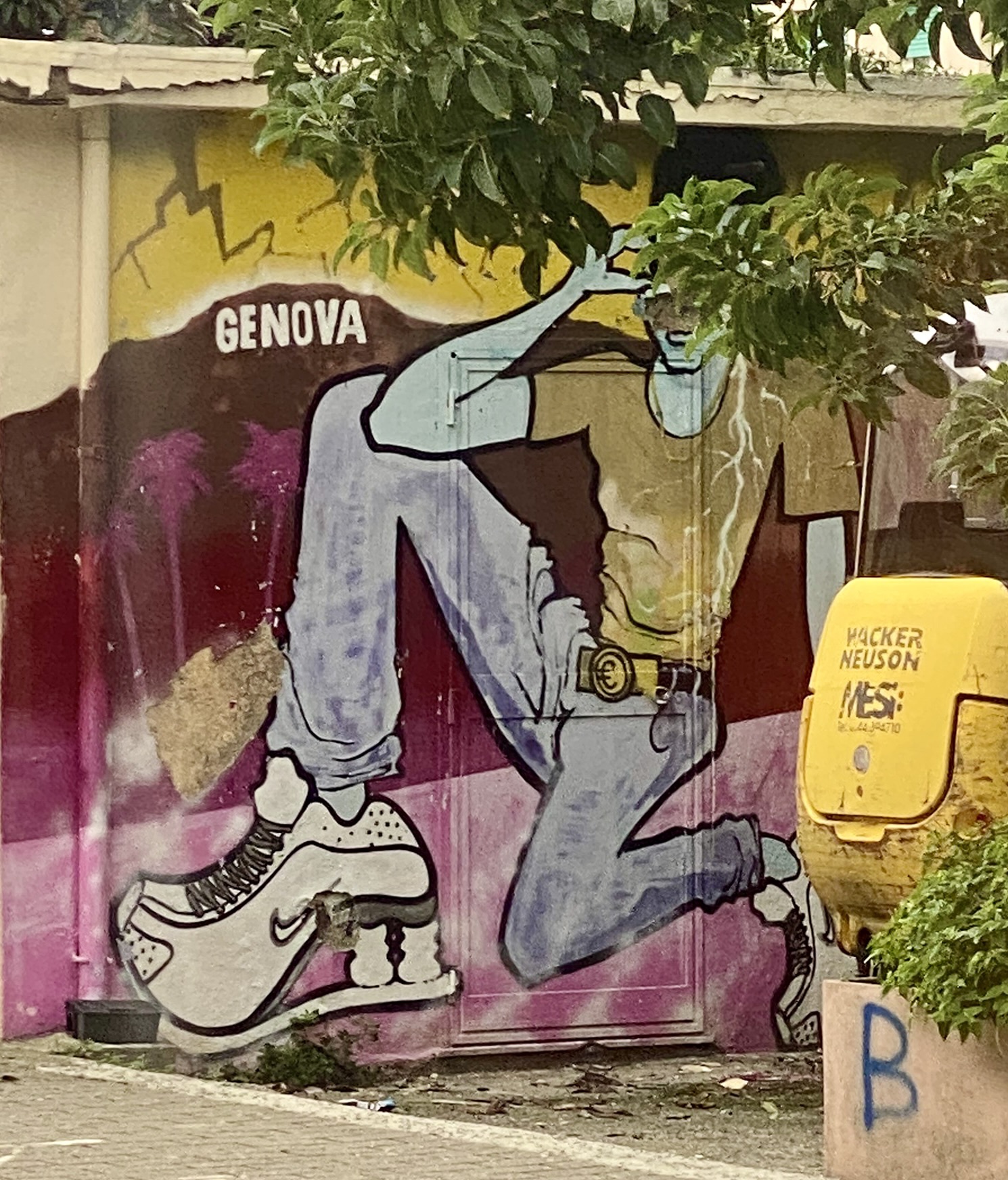
For being a large port, Genoa is one of the easiest cruise stops to walk out of, which is important when trying to maximize time in the city. Walk out of the Stazione Marittima, cross the wide bridge over the train tracks, and start heading east, with plenty of options to stop for a caffe.
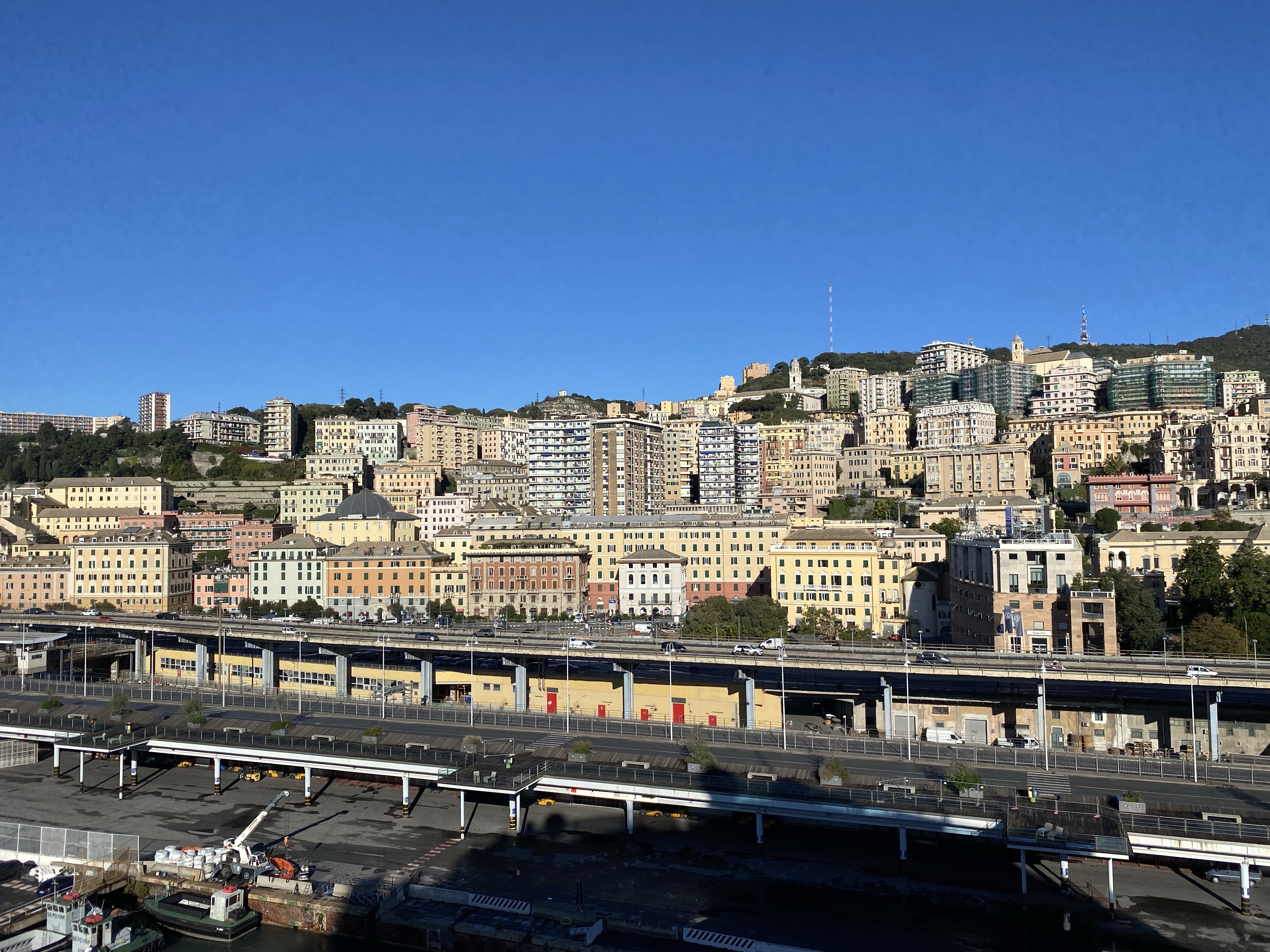
We had three separate cruise stops in Genoa. Unfortunately, our scheduled stop in Corsica was cancelled due to stormy seas, and the ship substituted the easy mainland alternative. We were quite disappointed as Corsica has been high on our travel list, but there is so much beauty to discover just outside of Genoa.
Our first day, we focused on the historic town, walking Via Garibaldi and meandering through the alley-like streets known as the caruggi. Via Garibaldi is wide, sunny, and touristy. The caruggi are the opposite! While they never felt unsafe, parts certainly felt unsavory. We clearly saw prostitutes loitering in doorways in the middle of the day. But there were also pleasant surprises: piazzas to have a drink and people watch, fun nooks for street food or coffee, and all types of small shops and workshops.
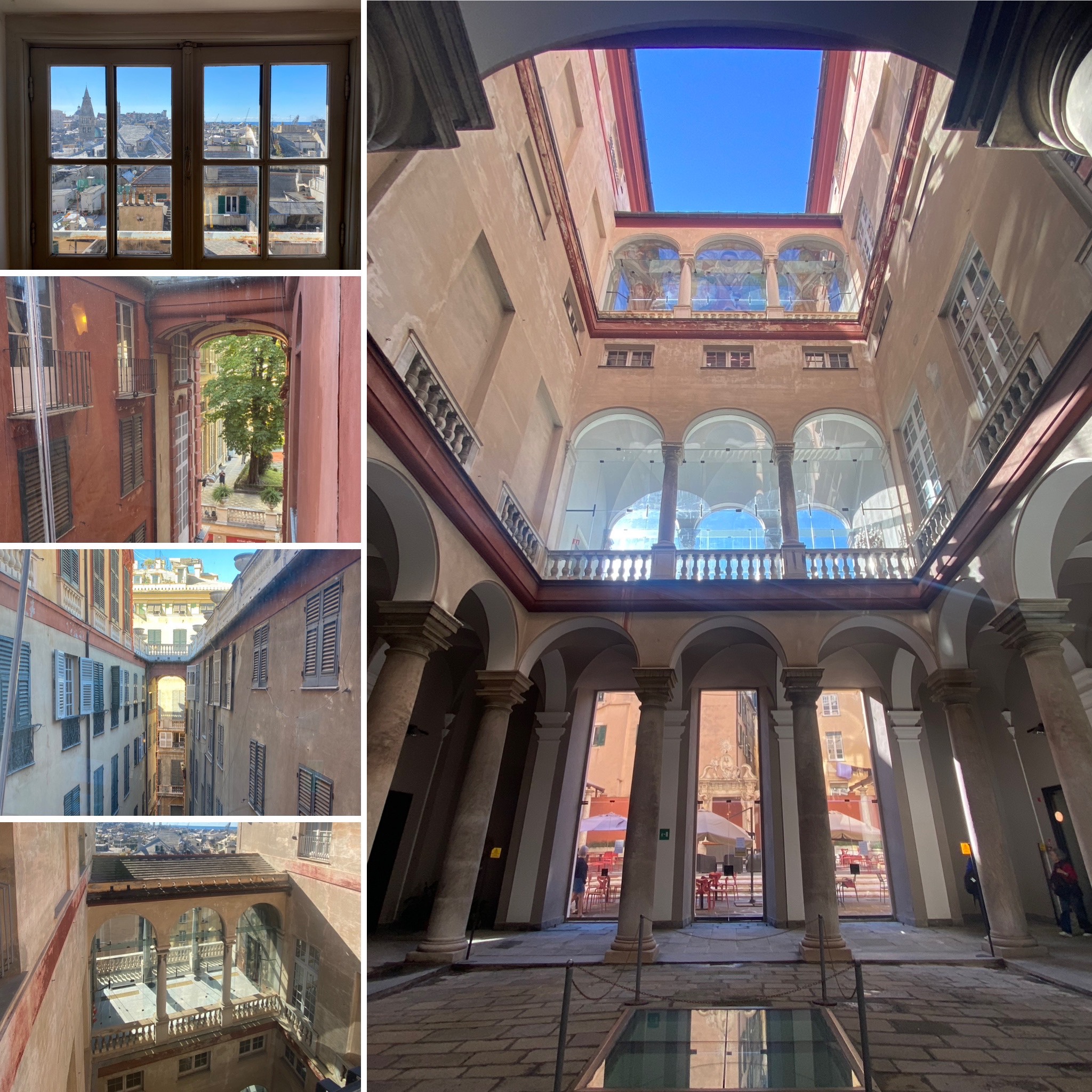
The bulk of the day was spent at the Musei di Strada Nuova, an impressive art museum. The museum is housed across three palazzi: Palazzo Rosso, Palazzo Bianco, and Palazzo Tursi. For being such a highlight of the historic center, it was actually a little difficult to figure out which buildings are part of the museum, what route to take, etc. We went into what looked like the entrance, only to be sent back to another building to purchase our tickets. At one point we found ourselves wandering the private hallways of the city’s government, as it turns out that the Palazzo Tursi is divided between the museum and the government offices. Fortunately a security guard sent us back to the street without issue (and the courtyard of Tursi is worth looking at). While there is astounding art throughout Italy, Strada Nuova is no exception.
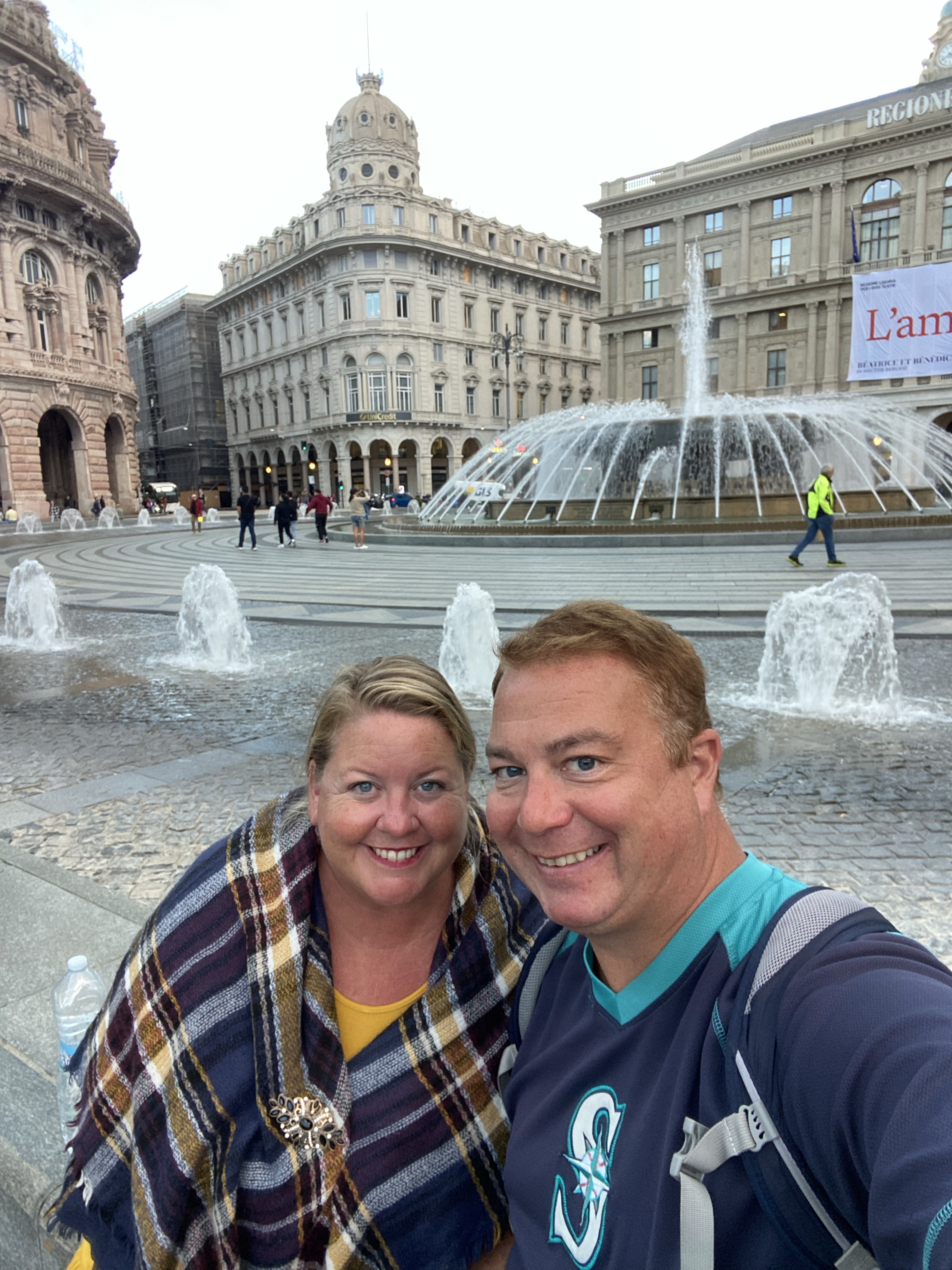
Genoa is also an ideal port stop for a coastal train ride. The train station is a short walk across the tracks from the cruise port. But if you buy your tickets online, there is even a tunnel that leads directly to the highest-numbered train platforms! We saw this as we exited the cruise port, to the right (east) of the walkway and down a set of stairs.
On another stop, we took the train to the eastern coastal suburb of Nervi and walked around. While it was too cold for sunbathing, we enjoyed the scenery from the coastal walking trails, which connect beaches and parks.
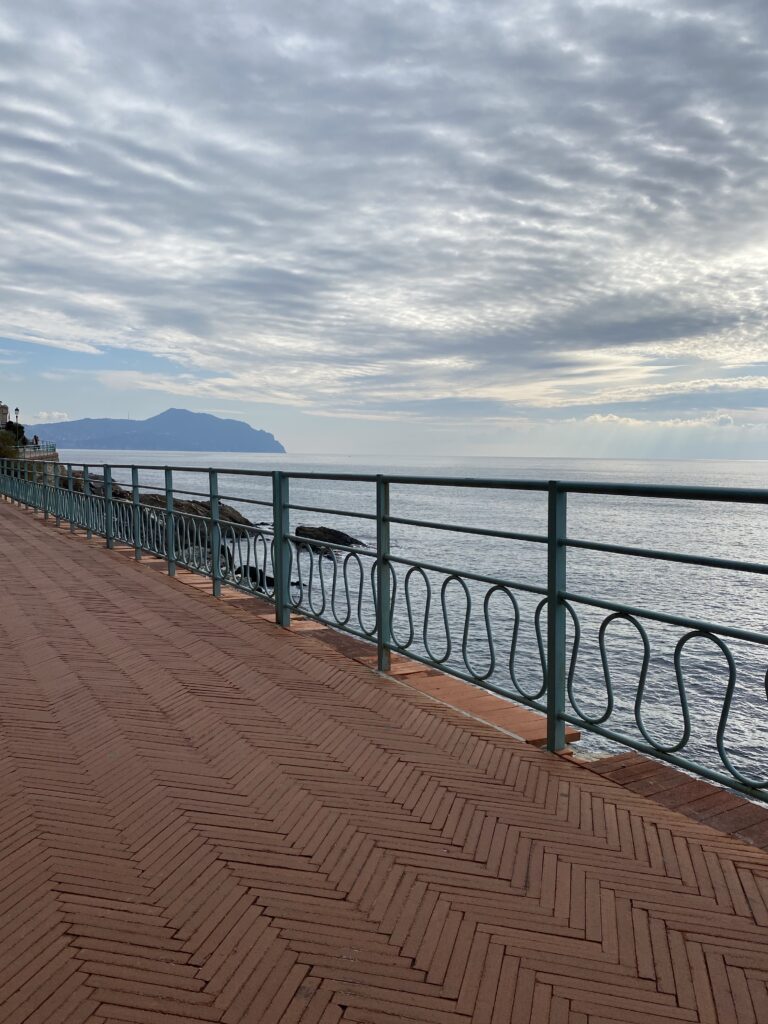
Portofino (via Genoa), Italy
The Italian coast near Genoa offers many opportunities to explore, and the train system is an exceptional way to get there. On our third stop in Genoa, we went to the nearby resort town of Portofino. The train only goes as far as Santa Margherita Ligure, where you will then have to walk or take a bus for the final two or three miles.

We actually liked Santa Margherita Ligure as a stop of its own. The buildings facing the water are all painted in a trompe l’oeil style to create the illusion of plaster details, shutters, etc. It is a colorful and interesting sight. We walked for about an hour through the pedestrian-friendly city, which felt authentically local. We stopped for a pizza, which was great even though we were not in Naples.

Truly you can eat wonderful pizza all over Italy. That’s one of things we learned while in Italy. Here are some other helpful tips we wrote about this beautiful county.
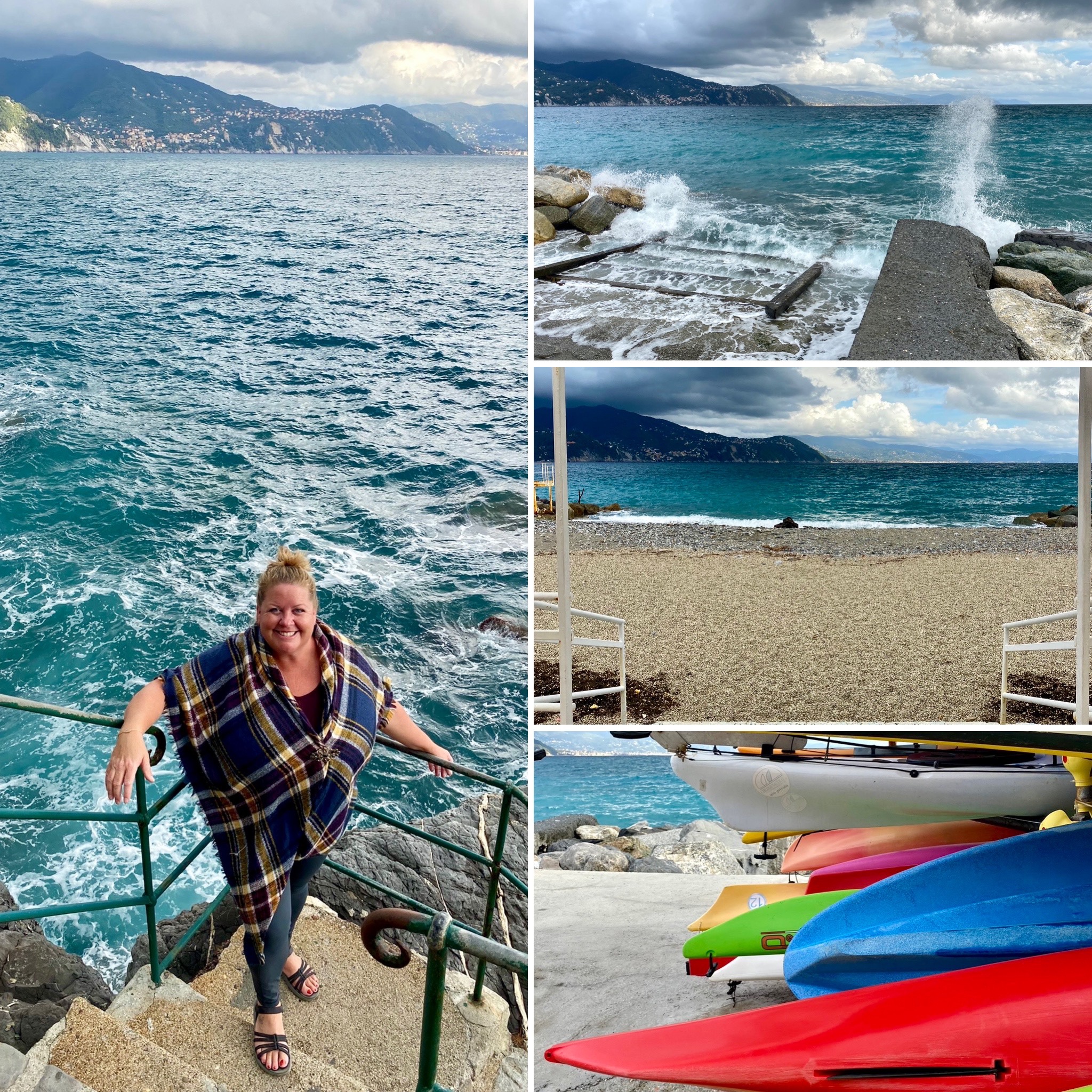
Then we started the stunning hike to Portofino. We had expected a boardwalk-style coastal walk, but the path diverts from the road into the hillsides, providing outstanding views of the coast, and sometimes traversing local backyards.
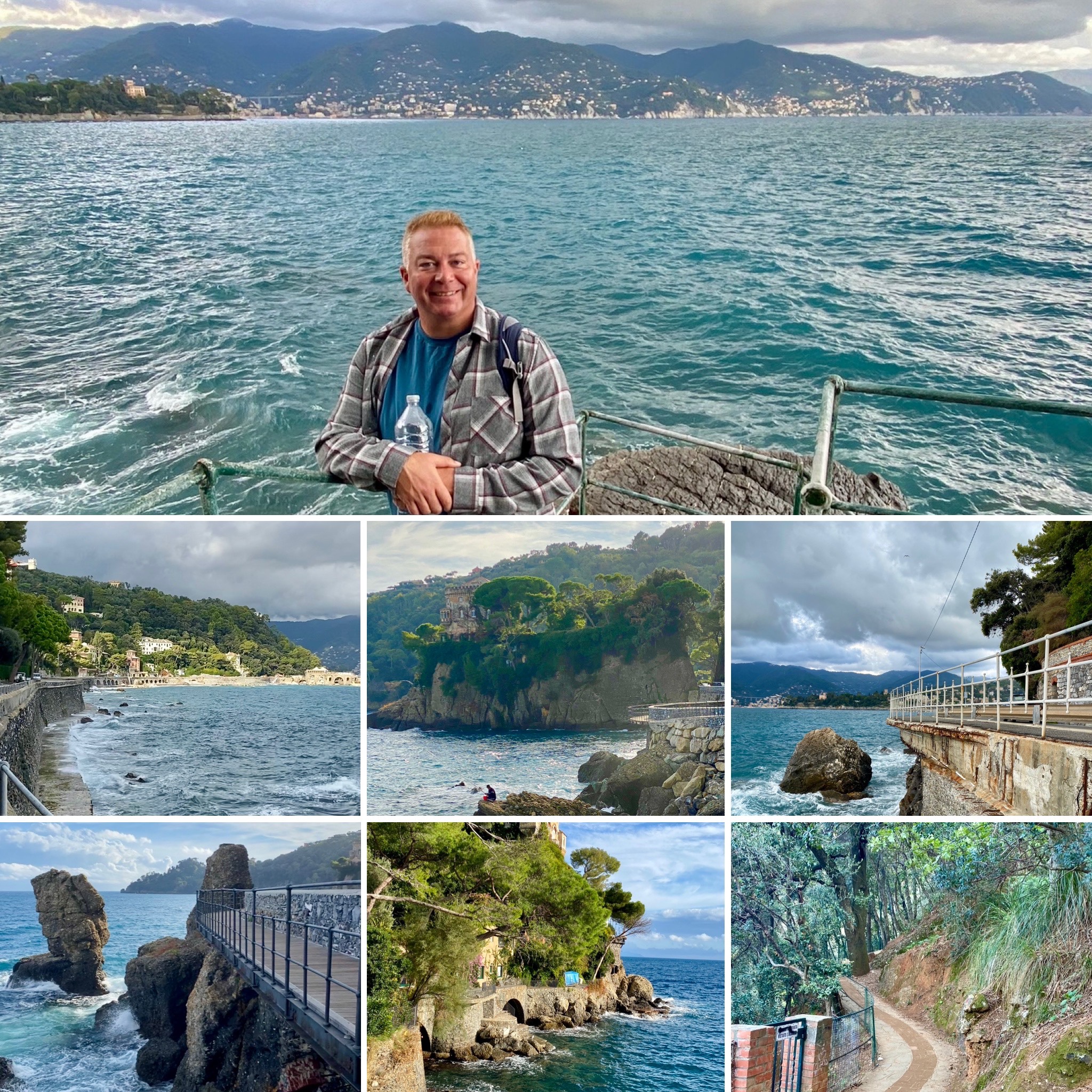
Portofino is certainly a tourist town, and by November, it was almost entirely shut down for the year. Most restaurants were closed, and those that were open seemed expensive and tourist-focused. Some souvenir shops and boutiques remained open. We stopped for gelato and watched the relaxed harbor traffic.
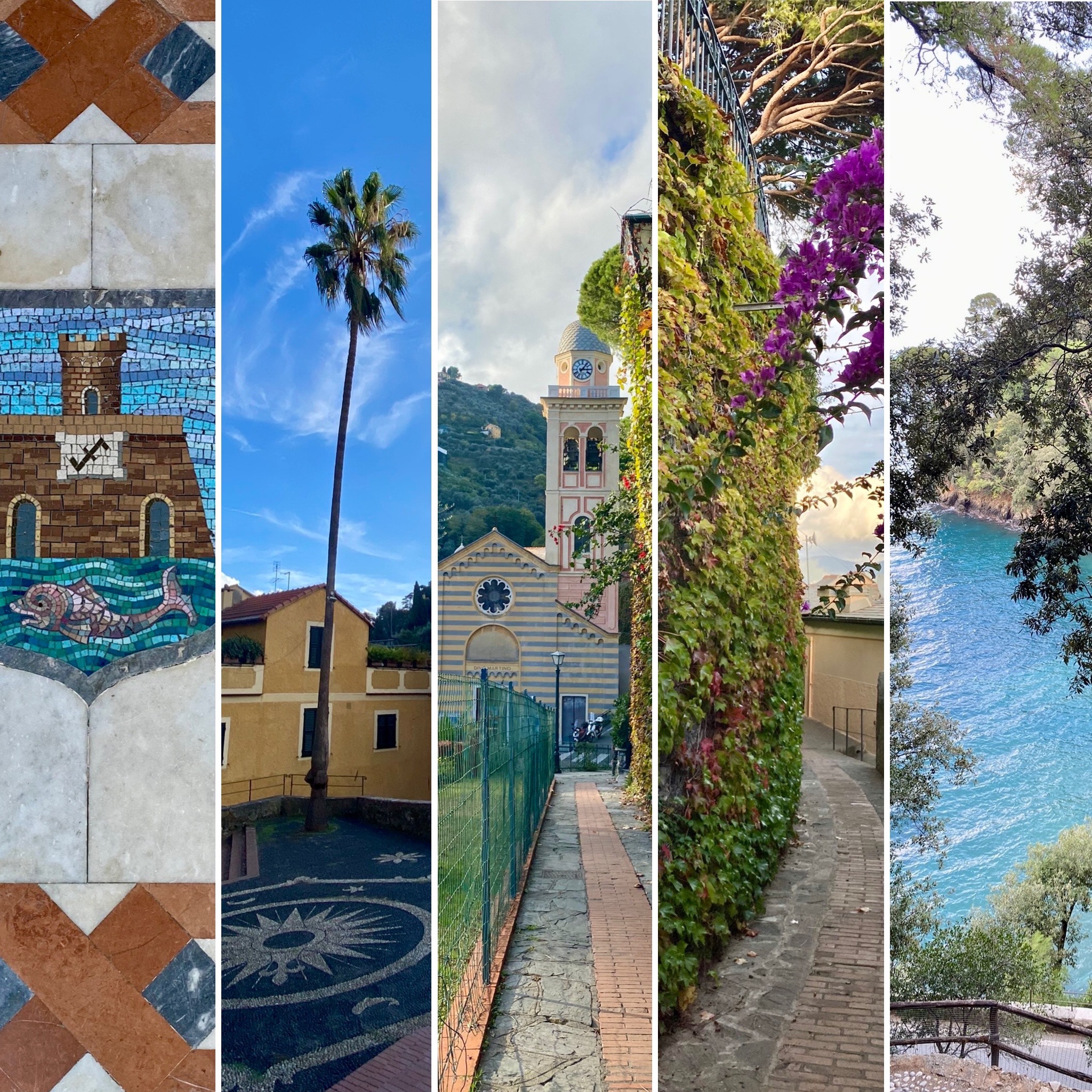
The weather was quite nice and it was good to see the harbor scene that we have previously seen in photographs and paintings, and then later saw recreated in Tokyo at DisneySea.
To get back we took a local bus back to the train station in Santa, and then back to Genoa by rail. The track hugs the cliffs as you sway back and forth swooning over the sumptuous sea views.
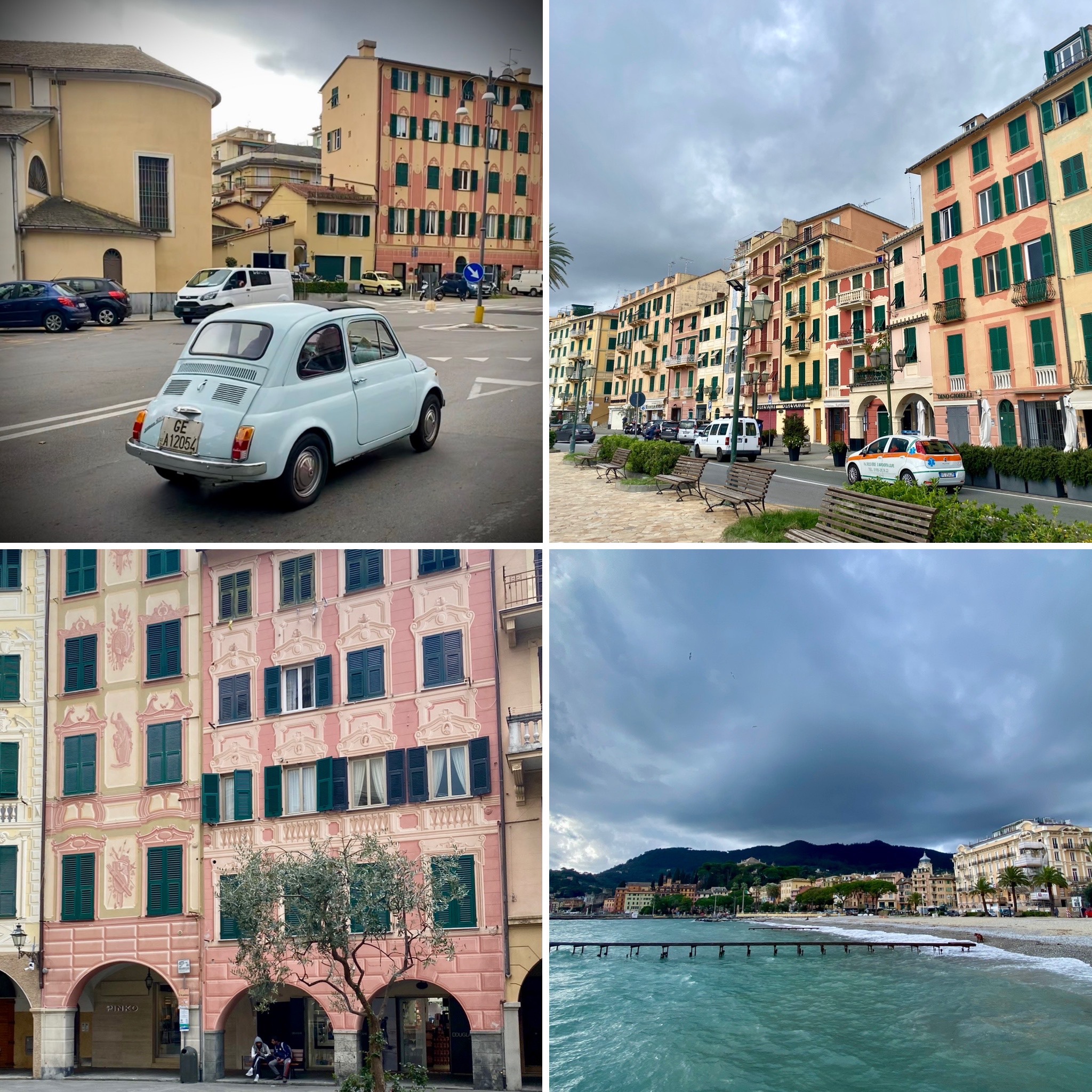
Overall we liked Santa Margherita Ligure and would consider coming back there. It seemed like a real city and a good place to enjoy the Italian waterfront without overspending. There are many other small Italian coastal towns, so if you want a Cinque-Terre-like experience that feels authentic without busting your budget, consider looking around this area.
Livorno, Italy
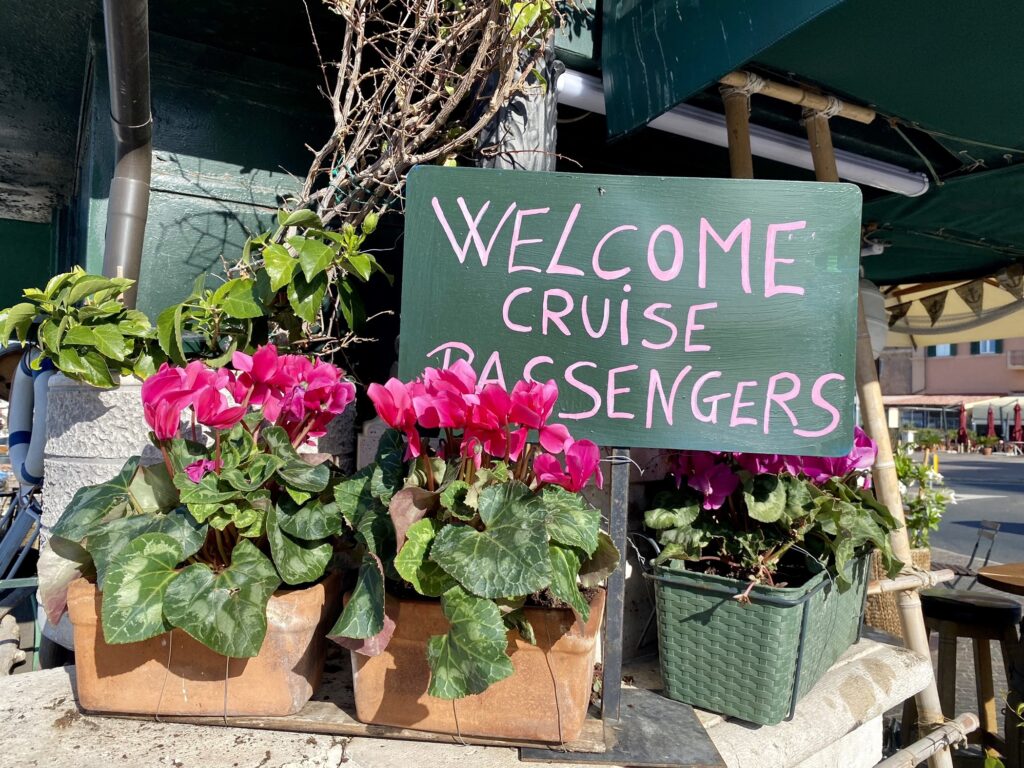
Most cruise visitors set off from Livorno to explore other areas of Tuscany. We had previously used it as a route to Pisa and we had already spent nearly a month in Florence. So we stayed close to explore the old port area, which has canals created by the Medicis when they ruled the area. This area is referred to Venezia Nuova and vaguely resembles Venice, although it is much quieter and less touristed.
Like most cities with historic canals, the city is best seen on a boat tour. We chose Livorno in Battello, who provides an hour-long tour with English translations through headphones. I had a few sights on my list for Livorno, but this tour basically took us past all of them.
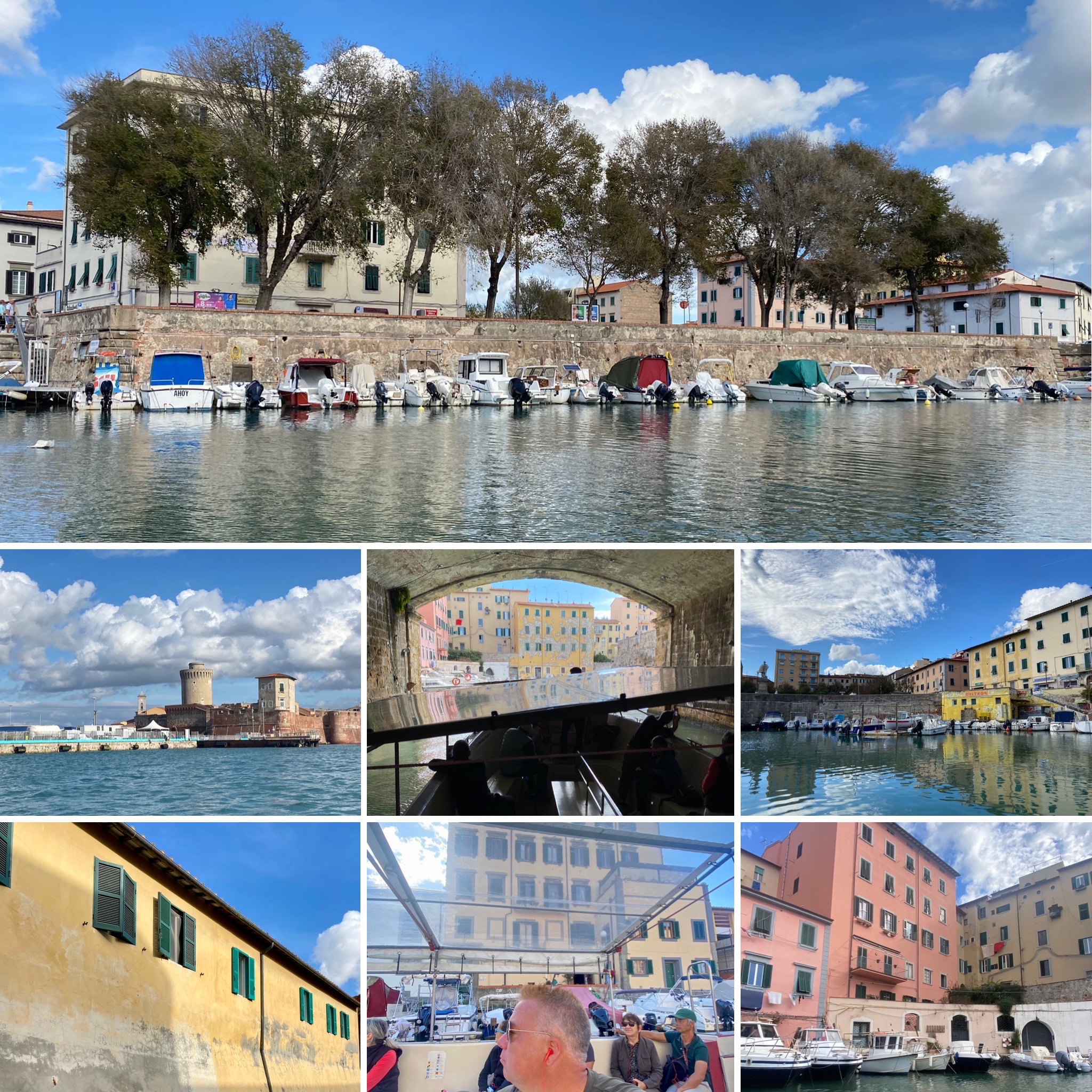
Following the tour, we walked around town further, strolling along the Terrazza Mascagni. We explored the market, ate a fine lunch, and ended our day at a small bar where we enjoyed a local amaro.
Cinque Terre (via La Spezia), Italy
Spezia was our port for a day of exploring the five towns of Cinque Terre by train. Each town has its own train station, so this is an easy method of transport. There is a Cinque Terre train card that offers unlimited rides on the train between the five towns, but it would not include the ride to and from Spezia, and we did the math and decided that it would cost us more to buy the card than to buy tickets as we needed them. While it was a minor hassle to book tickets over and over again, the Trenitalia app saved our passenger and payment information so that it was only a few clicks per ride.
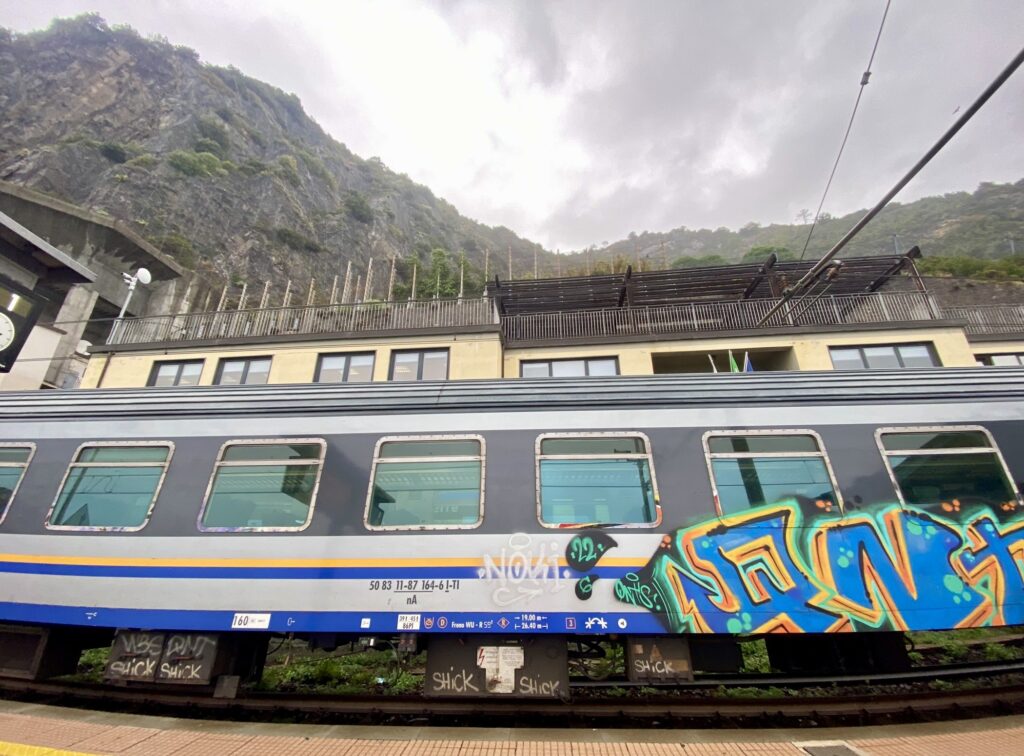
We set out on a terribly rainy day: the kind of rain that would have postponed an excursion if we were staying in the area. But with only one day to stop in Spezia, we braved the weather and kept with our plans.
We ended up getting to four our of the five towns, starting on the far west end at Monterosso and working our way back. Tammy’s rain jacket failed while at town one so it was a long, cold, wet day for her!
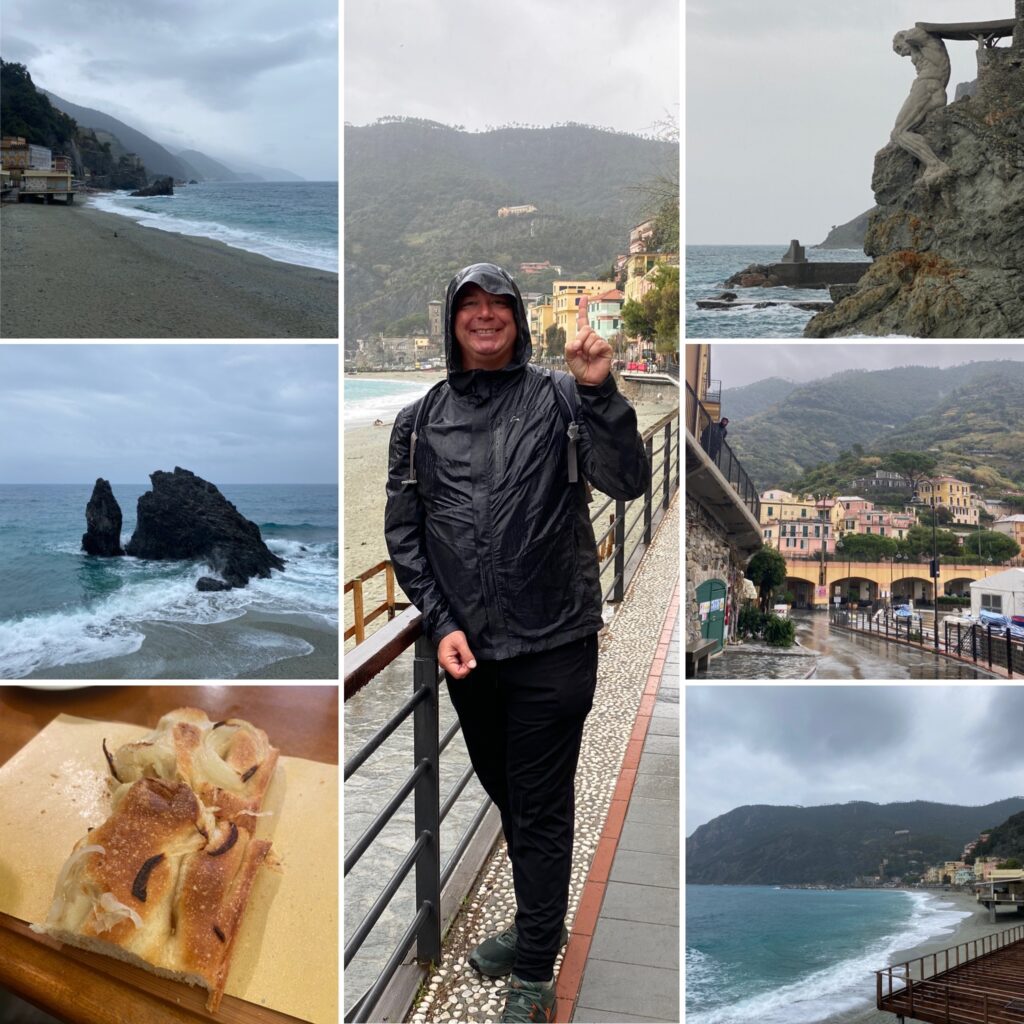
Vernazza had a protected bay and beautiful church to explore. Basically anything indoors was worth exploring that day.
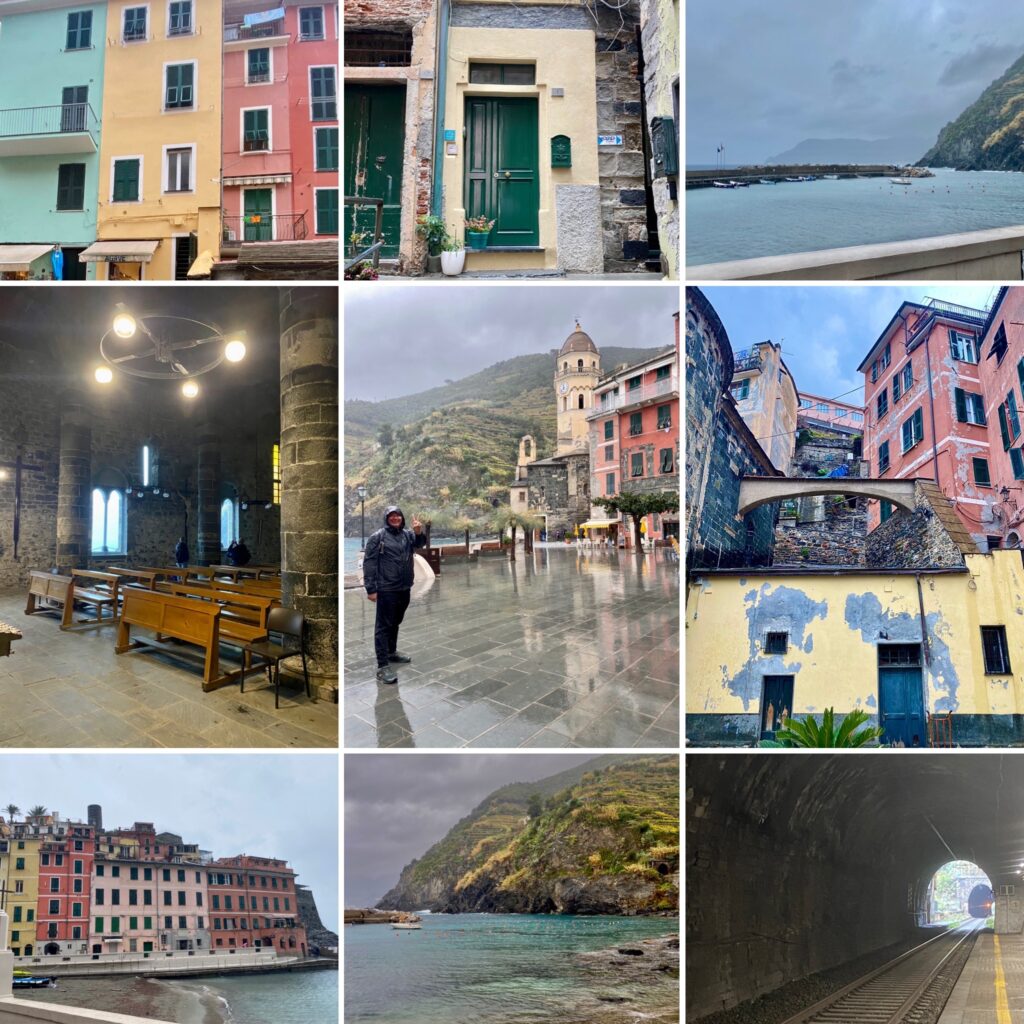
Corniglia is up a large hillside. A shuttle bus is offered, timed to when the trains arrive. The alternative is a series of terraced steps called the Lardarina. On the way up, we chose a different alternative: follow the paved road. It was a pleasant journey past farms and vineyards, with a more gradual climb. We used the Lardarina to come down. The views are spectacular in both.
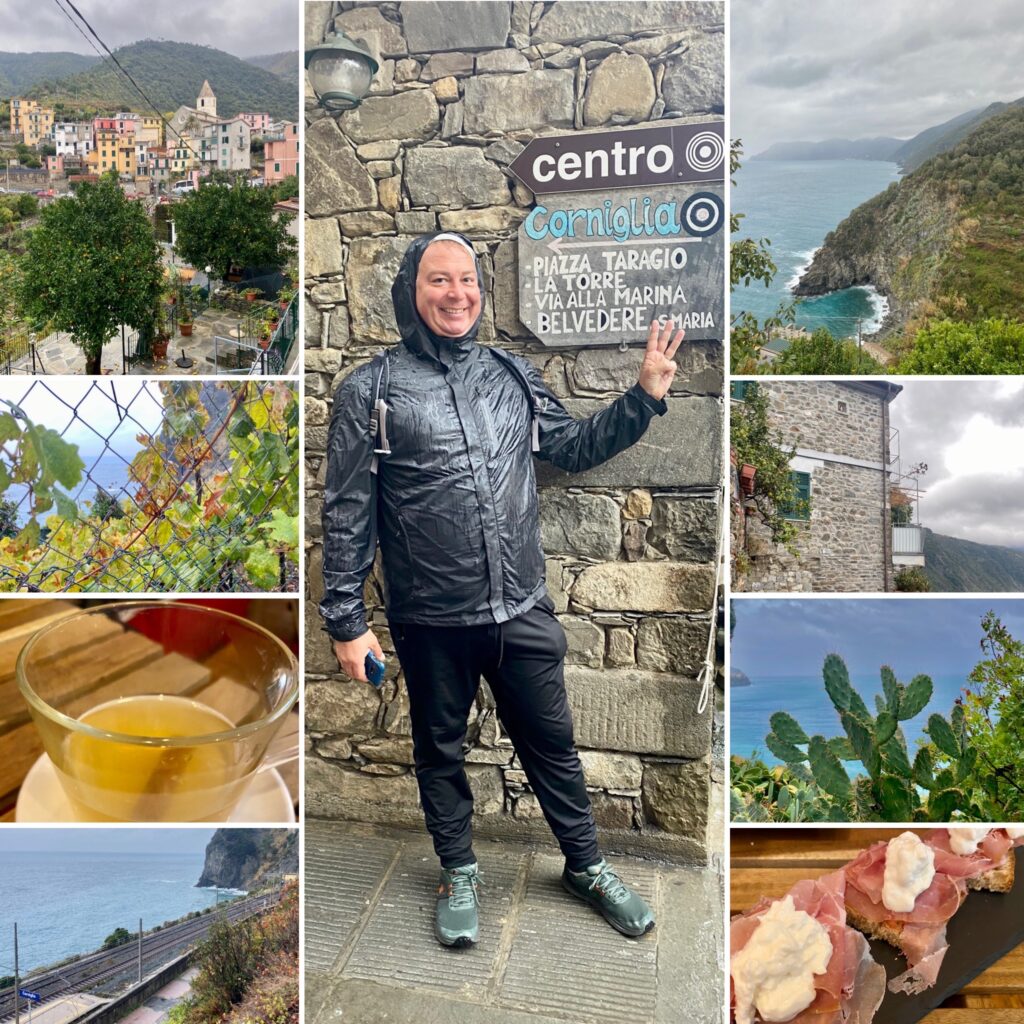
My highlight of the day was the time we spent in Corniglia, where we stopped for lunch at a small bar called La Scuna. Most establishments were closed, seemingly for the season, but here there was one barista who was watching the rain fall. We drank wine and amaro, and Tammy taught him how to make a hot toddy. He had heard of it but had never made one, and the warming drink matched perfectly with the wet day.
After the warm up in Corniglia, we jumped back on the train to see M,anarola, which is perched on the cliffs. It was like walking around on a colorful layered cake. Even the rain showers could not dampen the lovely pinks, greens, and yellows.
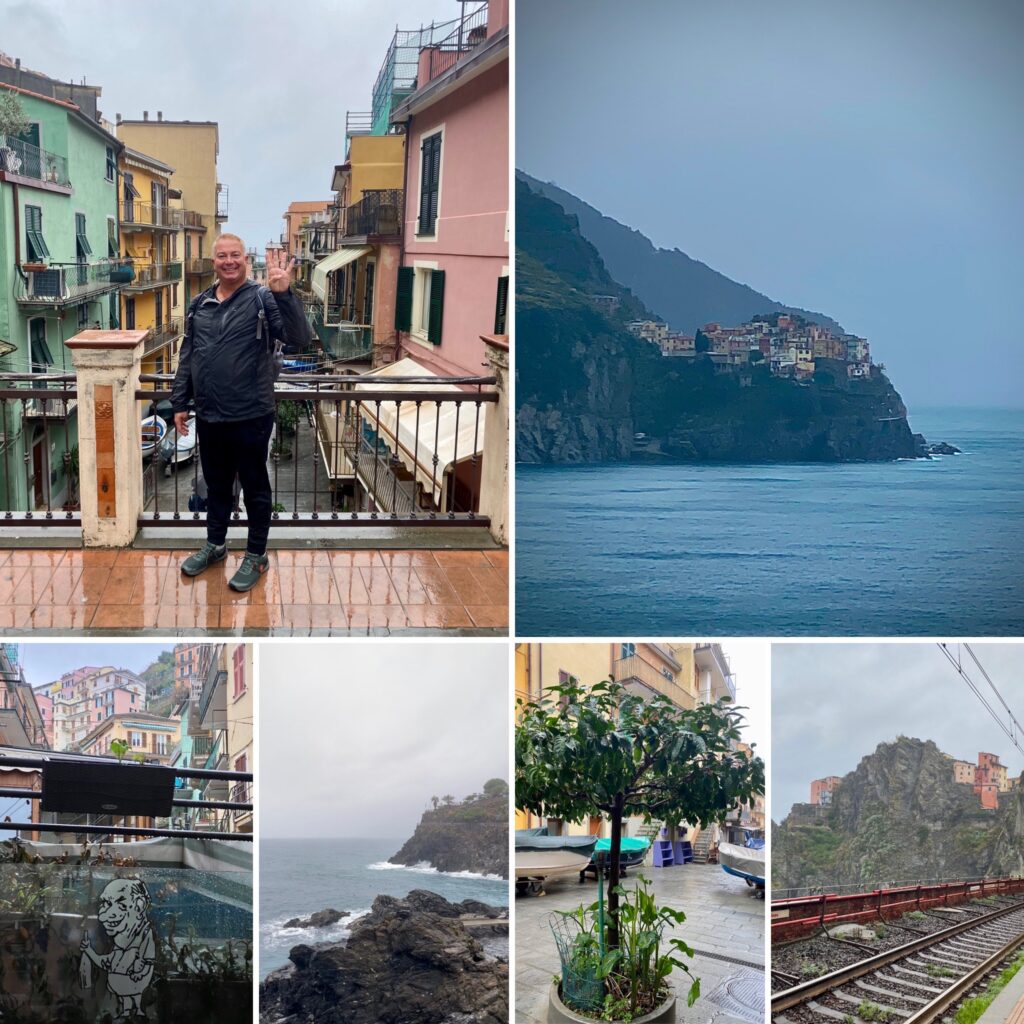
The rain also did not deter the crowds. It was still a very crowded experience! Whole train cars were filled with organized tour groups who were marched from the train station to restaurants for preset dining experiences, and the option to proceed further through the storm to see more of the town. We saw a lot of people staying under cover the whole time, and I wonder if they got the experience they were hoping for.
We skipped Riomaggiore as we were running out of time for the day. In each town we did a bit of walking around, especially around the gorgeous seaside areas.
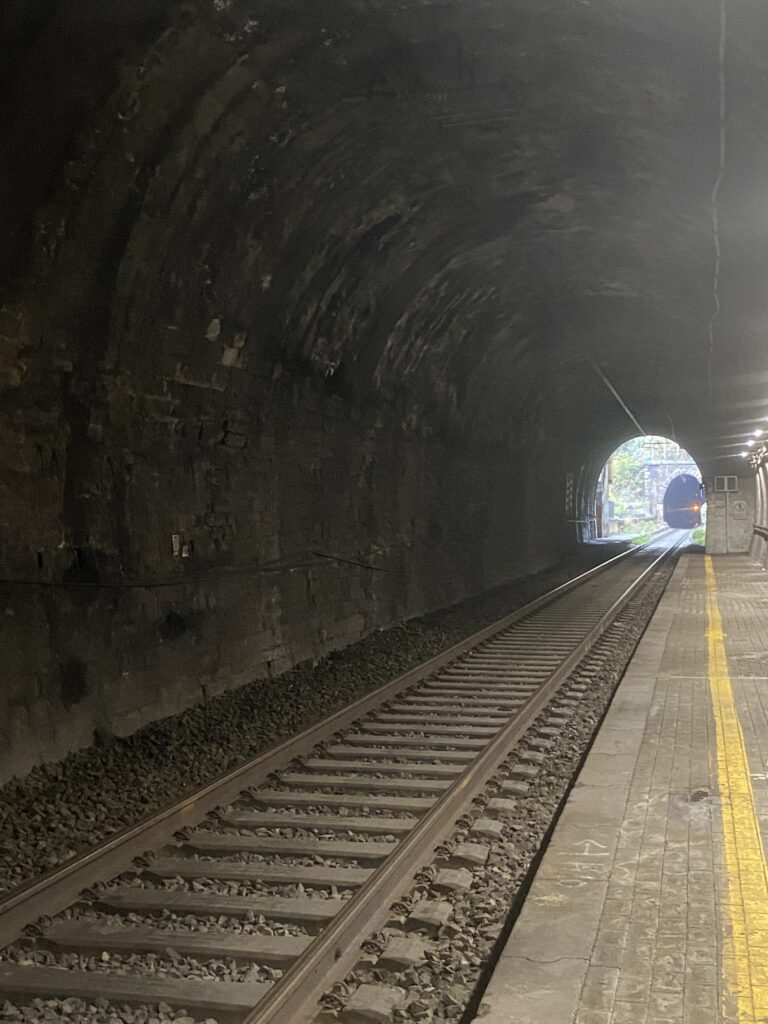
For us, it was worth going to, but mostly to have the experience of having done it. We aren’t usually “box checkers” but some places are important enough to want to brave the crowds, and we still had an interesting day.
Conclusion
Cruising offers a great way to get to a certain set of Italian ports, but it will not take you everywhere. The great Italian train system certainly helps expand the potential of each port city, without ever needing to pay for a shore excursion.
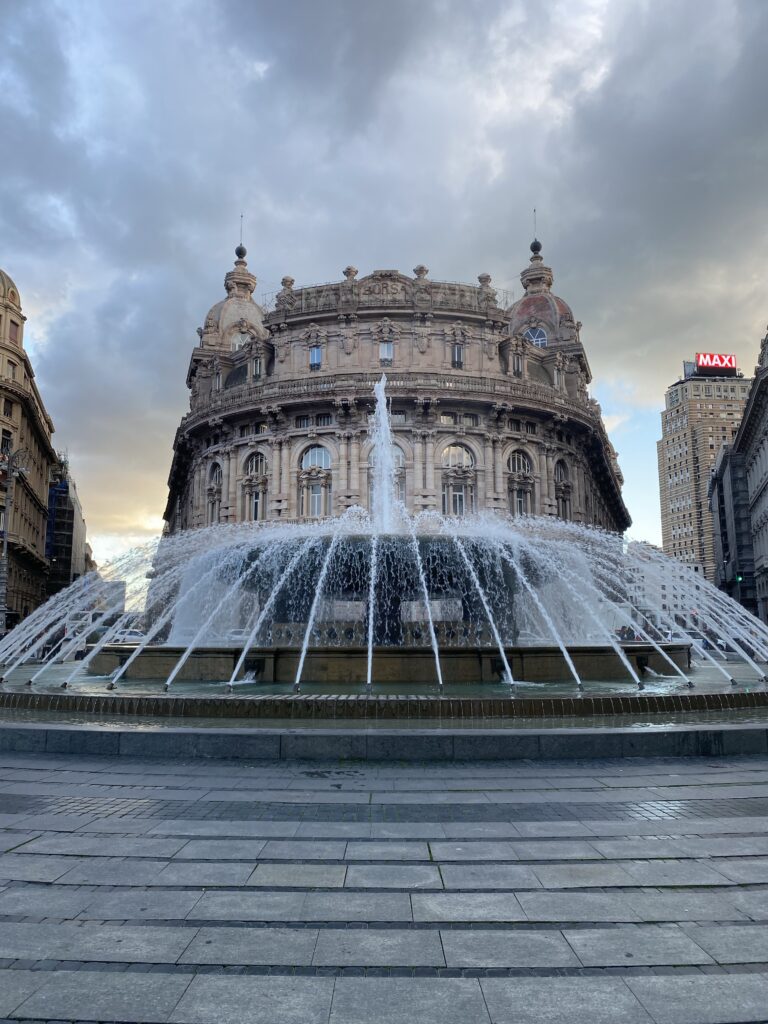
If you missed it: Click here to read our review of the two ships, and click here to read about the non-Italian ports.
Nicely written Corey
Thank you!!